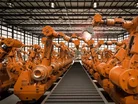What role will robotics and 3D printing play in the future of manufacturing?

Digitalisation is taking over the manufacturing world, forcing traditional fossil-fuelled methods out of the way and improving the flexibility of processes globally. IIoT and Industry 4.0 are a looming presence spurring businesses to adopt advanced automation solutions in order to hasten production, lower manufacturing costs, and remain competitive.
Top Technologies in Advanced Manufacturing and Automation, 2017 is part of business consultancy Frost & Sullivan's TechVision Growth Partnership Service program. The study covers the technologies of robotic exoskeletons, metal 3D printing, computer integrated manufacturing, nano 3D printing, collaborative industrial robots, friction stir welding/solid state joining, magnetic levitation (Maglev), composite 3D printing, roll-to-roll manufacturing and agile robots. These are expected to have the most impact across a variety of market segments, including automotive, healthcare, consumer electronics, aerospace and transportation.
"Developments in 3D printing materials, metal inks, printing techniques and equipment design are driving the global uptake of metal 3D printing," said Frost & Sullivan TechVision Research Analyst Ranjana Lakshmi Venkatesh Kumar. "R&D can enhance metal 3D printers' ability to print high-strength, lightweight prototypes and parts at low costs, making these printers highly relevant in the aerospace and automotive sectors."
The robotics market has also experienced huge advancements recently, and collaborative robots have the highest impact.
"Collaborative robots are gaining traction due to their ability to work alongside humans, ensure worker safety and integrate with existing environments," noted Frost & Sullivan TechVision Research Analyst Varun Babu. "R&D efforts to improve the level of interactivity and customization will bolster the adoption rates of collaborative robots, particularly in automotive, aerospace, logistics and warehousing, healthcare, and consumer electronics industries."
Robotic exoskeletons and agile robots are also important developments of note. The former is a wearable device that can increase strength and mobility of the wearer, and the latter are small robots which offer superior agility, efficiency, and uptime.
Overall, with greater government support and deeper convergence, advanced manufacturing and automation solutions will surely be the cornerstones of Industry 4.0.

